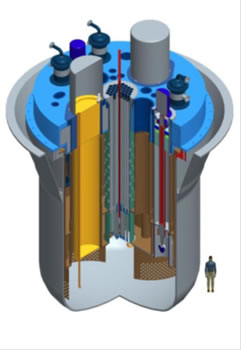
MYRRHA takes a step closer to realization
The Belgian Nuclear Research Centre (SCK•CEN) has awarded the contract for the technical design of an important component of MYRRHA. Following a selection procedure that took over two years another important step was made in the realization of this new multifunctional research infrastructure. MYRRHA is an innovative research reactor driven by a particle accelerator, and will be the first of its kind worldwide.
The contract that has been awarded, the Front End Engineering Design (FEED), consists of the technical design of all elements of the infrastructure, with the exception of the reactor itself and the particle accelerator. More specifically, this includes the design of the buildings, the cooling systems and the instrumentation and control of the reactor and the particle accelerator. “The design of the reactor itself has been carried out by our own team. But, of course, a reactor cannot work by itself. This FEED contract will cover everything that is not part of the SCK•CEN specializations”, clarified Hamid Aït Abderrahim, Director of the MYRRHA project.
Because of the technological challenges involved – there is no infrastructure in existence that is comparable to MYRRHA – an initial selection of candidates was made on the basis of proven technological competence. Following the global assessment of the remaining candidates, the contract was awarded to an international consortium consisting of the French company Areva TA, the Italian company Ansaldo Nucleare and Empresarios Agrupados from Spain. The Belgian company Grontmij will execute part of the tender as a subcontractor of Areva TA. “The selection was very strict, and we attached the greatest value to proven quality and credentials. We are fully confident that this consortium will bring the work to a successful conclusion”, confirmed Hamid Aït Abderrahim.
The contract represents a value of €24 million. As soon as this study and design contract has been completed this special project will be ready for construction, and the first contracts for the realisation of the various components of MYRRHA can be concluded.
The MYRRHA research reactor will contribute to the development of transmutation as a technique for recycling and processing highly radioactive waste. MYRRHA is scheduled to enter full operation in 2024-2025.
What is MYRRHA?
MYRRHA is a flexible research reactor driven by a particle accelerator, which will open the way to many promising technologies and applications. It provides an important contribution to solving the nuclear waste issue. This is done on the one hand by the development of transmutation as a technique for recycling and processing highly radioactive waste, while on the other hand it will also contribute to the more efficient use of the natural reserves of uranium, thereby ensuring that less nuclear waste is created. MYRRHA will also take over the role of the BR2 reactor for the production and development of radioisotopes that detect and combat cancers. Furthermore, it will contribute to the low-CO2 economy thanks to the major role that it plays in the development of fourth-generation nuclear reactors and nuclear fusion reactors. A study of the Strategic Projects Organisation Kempen (SPK) showed that the realisation of MYRRHA will generate up to 2,000 permanent jobs, both direct and indirect ones.

Who are the entities involved in the contract?
AREVA
AREVA supplies advanced technological solutions for low-carbon power generation. Its expertise and unwavering insistence on safety, security, transparency and ethics are setting the standard, and its responsible development is anchored in a process of continuous improvement.
Ranked first in the global nuclear power industry, AREVA’s unique integrated offer to utilities covers every stage of the fuel cycle, from nuclear reactor design and construction to operating services. The group is also expanding its renewable energies (wind, bioenergy, solar, energy storage) activities in order to become a European leader in this sector too.
With these two major offers in its portfolio AREVA and its 46,000 employees are helping to supply ever safer, cleaner and more economical energy to the greatest possible number of people.
Ansaldo Nucleare has significant experience with CANDU plants in Europe and with AP1000 plants too. The company plays a relevant role in the definition of safety standards and in the development of passive safety systems for Gen-IV reactors, specifically Lead-cooled Fast Reactors. Ansaldo had been involved since 1998 in Accelerator Driven Systems aiming at the transmutation of nuclear waste when Prof. Rubbia first presented his proposal at CERN. Since 2002, the cooperation with SCK-CEN has been strengthened within the framework of existing European research programmes, from the initial concepts to the recent FASTEF/MYRRHA, with a centralised multi-disciplinary team based in Mol.
Empresarios Agrupados is a leading international architect-engineering company. Active in nuclear and conventional power generation projects from new built power plants to operational services and decommissioning, Empresarios is also a major player in EU TACIS, PHARE & EURATOM projects for the development of GEN-IV technologies, as well as in the international ITER fusion reactor project. Its 200 years old collaboration with SCK-CEN includes work on the preparation of the EU’s SET (Strategic Energy Technology) Plan and projects such as ADS, EUROTRANS and CDT, all of which are aimed at enhancing the contribution that MYRRHA will make to new generation reactors and supporting its technology.
Grontmij is a major player in Belgium in the industrial installations and buildings sector. It is also present internationally in sectors such as the decommissioning of nuclear power plants in the Netherlands and the provision of services to the Swedish nuclear industry. It has been partly involved in the study of the Lead-Bismuth process design by SCK-CEN. As it is very familiar with Belgian local rules and regulations, Grontmij’s participation in the consortium is a real asset for the MYRRHA project.
|

